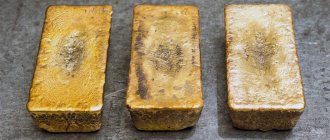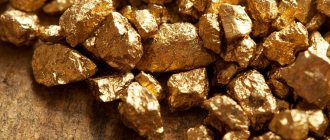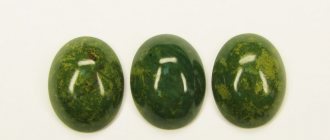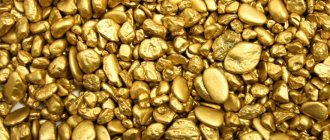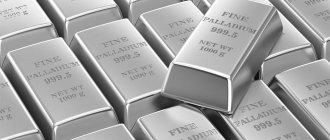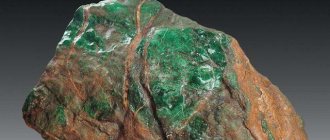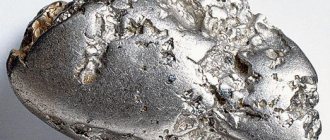Rainbow metal
The discovery of iridium dates back to 1803, when it was obtained in sufficient quantities for identification. The English chemist S. Tennant treated South American natural platinum with aqua regia (a freshly prepared mixture of nitric and hydrochloric acids). In the collected insoluble sediment, previously unknown metals were discovered, one of which was iridium.
The newly discovered metal manifests itself in compounds as two, three, four and hexavalent elements. The substances that are formed have a wide color palette. Their color varies from bright yellow to dark blue and black. It is because of this property that iridium got its name. Translated from ancient Greek, ἶρις means “rainbow”.
Chemical and physical properties
Iridium is a metal that is hard and brittle at the same time.
Iridium crystals
Chemical and physical properties:
- It has a high density - up to 22650 kg/m3.
- The oxidation state in compounds is most often +3, +4, rarely +1, +2, +5 and +6.
- Melting point 2466 °C.
- Iridium begins to boil at 4428 °C.
- Chemically resistant metal (under normal conditions); does not react with alkalis and acids, even with aqua regia.
- The metal color is silver-white.
When heated, it reacts with halogens (fluorine, chlorine, bromine) and oxygen.
| Properties of the atom | |
| Name, symbol, number | Iridium / Iridium (Ir), 77 |
| Atomic mass (molar mass) | 192.217(3)[1] a. e.m. (g/mol) |
| Electronic configuration | [Xe] 4f14 5d7 6s2 |
| Atomic radius | 136 pm |
| Chemical properties | |
| Covalent radius | 127 pm |
| Ion radius | (+4e) 68 pm |
| Electronegativity | 2.20 (Pauling scale) |
| Electrode potential | Ir←Ir3+ 1.00 V |
| Oxidation states | 9, 7, 8, 6, 4, 3, 2, 1, 0, −1, −3 |
| Ionization energy (first electron) | 868.1 (9.00) kJ/mol (eV) |
| Thermodynamic properties of a simple substance | |
| Density (at normal conditions) | 22.65/22.56±0.01[2][3][4] g/cm³ |
| Melting temperature | 2739 K (2466 °C, 4471 °F)[2] |
| Boiling temperature | 4701 K (4428 °C, 8002 °F)[2] |
| Ud. heat of fusion | 26.0 kJ/mol |
| Ud. heat of vaporization | 610 kJ/mol |
| Molar heat capacity | 25.1[5] J/(K mol) |
| Molar volume | 8.54 cm³/mol |
| Crystal lattice of a simple substance | |
| Lattice structure | cubic face-centered |
| Lattice parameters | 3.840 Å |
| Debye temperature | 430.00 K |
| Other characteristics | |
| Thermal conductivity | (300 K) 147 W/(m K) |
| CAS number | 7439-88-5 |
We recommend: MELCHIOR - lost and found
The crystal lattice is face-centered, cubic.
Iridium - space wanderer
Although iridium accompanies platinum, it is quite rare in the earth’s crust. There is a version that due to the large specific gravity during the formation of the planet, iridium went deep into the composition of the core. But this is only one of the hypotheses. Iridium is found much more often in meteorites. It is this property that serves to determine the origin of rocks. The high concentration of iridium indicates their meteorite origin.
Global production volumes confirm iridium's reputation as a rare metal. According to the latest official data, iridium production has now stabilized at 6 tons per year with slight fluctuations in one direction or another. This volume is not even enough to fill a 300-liter barrel to the top. For comparison, annual platinum production averages 180-200 tons.
Dinosaurs and the “gift” of the Universe
Where is the iridium, and where are the dinosaurs, what is the connection... According to many scientists, it is direct.
According to the generally accepted theory, during the emergence and formation of planets, stratification occurs - heavier elements are “attracted” to the core of the planet, the lighter the element, the higher it is towards the surface. Therefore, there should not be very heavy iridium on the surface. Where did heavy platinum come from on the surface of the Earth - from space.
Why dinosaurs became extinct - a link in the same chain. Paleontologists, geologists and other scientists believe that the cause of the extinction of dinosaurs was a meteorite fall. Moreover, the time (65 million years ago) and place (Yucatan Peninsula) are called. The crater from the fall turned out to be quite large - 180 km in diameter and 900 meters in depth. Dust clouds obscured the Sun for several years. Plants died, then herbivores died out of starvation, then carnivores (there was nothing left to eat). The ecological system collapsed.
It’s sad: along with dinosaurs, flying dinosaurs went extinct on land, and many species of mollusks and waterfowl reptiles went extinct in the sea.
Iridium anomalies confirm the hypothesis. They were found in marine sediments, in a clay layer that formed 65 million years ago.
And the bones of dead dinosaurs contain an abnormally high amount of iridium, which indirectly confirms the theory of an asteroid fall.
What does iridium have to do with it, the persistent and inquisitive reader will ask. With asteroids.
The Yucatan asteroid (like many others) brought a large amount of rare metals to the Earth from deep space.
We recommend: BRONZE - an alloy for all times and peoples
In total, more than 200 meteorite craters have been explored on the surface of the Earth.
It turns out that the precious metal originated from outer space and is a gift from the Universe.
Informative: scientists have calculated that the entire supply of terrestrial platinum group metals would fit into 160 asteroids, each 20 km in diameter.
Rainbow metal
The metal was discovered and given its name by the Englishman S. Tennant, a chemist. While conducting experiments with native platinum, the chemist also examined the solutions remaining from the experiments. And not in vain - in them he discovered multi-colored salts of an unknown element.
Iridium was named after the rainbow (in Greek iris) - a multi-colored miracle.
This is not about the color of the metal, it is about the variety of colors of iridium salts:
- K3IrCl6, IrF6 - golden yellow crystals;
- KIrF6 - white crystals;
- Ir2O3 - blue, blue-black crystals:
- IrCl2 - green crystals;
- Na2IrBr6 - crimson color.
There are iridium compounds colored olive, brown, pink, and golden.
Say a word about clever Klaus
K. Klaus, a Russian chemist, continued his research on iridium. The work was carried out for about two years, and the enthusiastic Klaus literally lived in the laboratory all this time, eating and sleeping there.
The scientist also studied other platinum metals, but it was the rainbow metal that won his heart. Inaccuracies in metal information have been corrected. Klaus suggested that they were admitted because of the study of iridium mixed with ruthenium (also a platinum group). The scientist gave recommendations on the technology for extracting platinum group metals (including iridium).
Applications of iridium
The main advantages of rainbow metal are:
- infusibility
- hardness
- chemical resistance
Iridium is rarely used in its pure form. When it is added to alloys with other refractory metals, materials are obtained that can operate at temperatures above 2000 0C. Adding 10% iridium to platinum almost triples the hardness of the alloy. The weight standard is made from this material.
Iridium's refractoriness, combined with chemical resistance, has found its way into spark plugs. Previously, such spark plugs were only available for sports cars. Their uniqueness lies in the fact that their service life is more than 120,000 km, versus 30,000 km for conventional nickel spark plugs.
In jewelry, iridium is used as an additive to platinum. And perhaps that small particle of rainbow metal that is part of your jewelry was formed somewhere billions of light years from Earth on the other side of the Galaxy.
Rating of the most expensive jewelry metals
For some reason, it has become such a thing in the jewelry world that everyone considers platinum to be the most expensive precious metal, but is this really so? There are many publications that like to compile ratings: the most expensive Christmas tree decorations; the most expensive hats in the world... This time we propose to evaluate what the most expensive precious metals used in the jewelry industry actually are. We especially emphasize that the conversation will be about jewelry metals; we will not touch upon just expensive and rare metals on the planet.
1. Cost $225.1 per 1 gram . So, we give first place to the jewelry metal “ Rhodium ”. In principle, those people who consider platinum the most expensive metal are right, because rhodium also belongs to the platinum group, but the compositions of these precious materials are slightly different. Rhodium has a silvery-white color and is used as a finishing material; for example, modern jewelry-making techniques make it possible to coat white gold and silver items with a thin layer of rhodium.
So what is rhodium used for if jewelry is not made from the metal itself? First of all, rhodium has high strength, it is resistant to corrosion, and also has reflective properties. That is why, in order for your jewelry to last for more than one generation, it is necessary to apply a thin layer of rhodium on top. This metal is also added as an alloying mixture to palladium and platinum. For reference, alloying means strengthening.
Jewelry with a layer of rhodium is wear-resistant, scratch-resistant, has a bright shine, does not darken, and rhodium is hypoallergenic. For example, if your skin is sensitive to silver or gold, then the rhodium layer will prevent an allergic reaction from developing. Rhodium is a very rare metal, but not radioactive; only a few tons are mined per year.
2. Cost $69.1 per 1 gram . We rightfully give second place to platinum . At first, platinum was not classified as a separate group, but was considered white gold, and the most interesting thing is that counterfeiters were the first to use it to replace expensive silver and gold. At the time, this seemed like the best option, but in the middle of the 18th century, platinum received its own group and became an independent metal.
Platinum’s properties are quite ambiguous: chemically, this metal is recognized as the most stable. Platinum does not oxidize, retains its color when exposed to high temperatures and cooling, and acids cannot affect it. Platinum has a high weight and density, which makes it durable, it does not wear out and is a good support for precious stones. That is why many famous diamonds are set in this expensive metal, for example, the Koh-i-Noor diamond.
However, despite the high cost, jewelry is still created from platinum, this is due to the high ductility of the material. From one gram of platinum you can create a very thin but strong wire about 2 kilometers long. This is why jewelers love and use platinum, not only does it have a beautiful white shiny color, but it can also be used to create flexible jewelry.
3. Cost $29.7 per 1 gram. Bronze goes to another common jewelry metal - gold, which seems to be intended by nature for use in the jewelry industry. It occurs in its pure form, unlike platinum, is resistant to corrosion, ductile, compact and homogeneous. In addition, gold is considered the most malleable metal, much like the situation with platinum; from one gram you can forge a wire 2.4 km long.
But in terms of chemical strength, gold is still inferior to the platinum group: rhodium and platinum. However, if you are not going to dip your jewelry in sulfuric acid or throw it into a melting furnace, then jewelry made of gold of any standard and type: white, red, yellow will wonderfully add to your home jewelry collection.
4. Cost $16.5 per gram . The fourth place goes to iridium . Many will be surprised to see this metal in our rating, because no one has heard of iridium being used to create jewelry. However, this is true, the same situation arises here as with rhodium; jewelry is not made from iridium itself, but this metal is added to platinum to make it almost three times harder.
According to its properties, iridium is a very heavy, durable and hard metal, although brittle. Adding just 10% iridium to platinum makes the jewelry virtually wear-free. Therefore, this metal is widely used by jewelers all over the world, in addition, iridium-platinum products are very, very beautiful.
5. Cost $14.7 per 1 gram . With a bit of a twist, we still add ruthenium . This metal is named after Russia, because Ruthenia means Russia in Late Latin. Rhodium is also a platinum group metal, but the most fragile of all of the above. But jewelers still occasionally add it to platinum, thereby giving ruthenium an honorable fifth place.
6. Cost $14.5 per 1 gram . Palladium , which has recently literally conquered the jewelry industry due to its properties: it is the most ductile of the platinum group metals, light, flexible and fusible. Jewelers successfully use all these qualities to create stunning jewelry masterpieces, because such flexibility of palladium allows you to create completely crazy fantasies and shapes of precious items. Do not forget that palladium is the cheapest of the platinum group, but it also has anti-corrosion properties and does not tarnish, so it is good to add to other precious metals.
7. Cost $0.6 per 1 gram . So, we got to probably the most common precious metal - silver . Note that in terms of cost it is the cheapest, but also the most used. The main advantage of silver is that, like gold, it occurs in its native form, which means it does not have to be smelted from ore.
In fact, silver is far superior to platinum in its qualities; it has a noble shine that is brighter and more distinct than other precious metals. In addition, rhodium-plated silver will retain its color for a long time and will not darken. Silver goes well with any precious or semi-precious stone and looks great on both men and women.
8. Cost 1,750 rubles. per gram . Since we are talking about jewelry metals, it makes sense to briefly talk about other jewelry alloys that can hardly be called precious, but they are still used to create jewelry. So, titanium , this metal is now conquering the heights of jewelry and more and more jewelry companies are using it in their work. We wrote a separate article about titanium, so we will not dwell in detail on the advantages of this material.
9. Cost 1,750 rubles per gram . Along with titanium is tungsten , which is very hard, wear-resistant and heavy. On the one hand, it is not expensive, but in terms of technology, tungsten is very difficult to work with. Tungsten is considered a masculine metal and is used in the jewelry market to create distinctly masculine jewelry.
10. Cost 1.5 rubles per gram . Cupronickel , which is essentially an alloy of copper and nickel. Quite often, jewelers use it to create rings, bracelets and earrings. However, cupronickel is most often used to work on cutlery and accessories.
Please note that we described the cost of the last three metals in rubles, because converting into dollar equivalent simply does not make sense, there will be too many zeros after the decimal point. We have listed almost all modern jewelry metals, at least the most used ones. As can be seen from the article, each precious metal has different properties, but now, by creating various alloys, you can play with the quality of jewelry and its effect on the body. Therefore, now, if you hear that silver is darker from sweat, and gold cannot be worn in the bathhouse, just ask if your products are plated with the same rhodium.
How much does it cost in 2021
In nature, iridium is found about 30 times less often than gold and platinum, which makes it not only one of the most unique metals, but also one of the most expensive. The average price in 2021 on the world market ranges from $110 to $200 per gram.
It is impossible to buy iridium on the stock exchange or through any financial funds. The substance is supplied either directly by manufacturers or by a small group of sellers who distribute the silver-white metal in ingots.
In the Russian Federation, as in many other countries of the world, there is criminal liability for the illegal purchase and sale, storage and sale of iridium.
Metal in nature
Pure iridium does not occur in nature. Almost always this is a combination with osmium, which is why professionals use the terms “osmic iridium” and “osmiridium alloys”.
There are indigenous deposits of osmic iridium in several regions of the planet: Russia, Canada, USA, South Africa, Papua New Guinea.
Other satellites of the iridium metal in the ore are rhodium and ruthenium.
At mining sites, a closed (mine) method is used.
The total global volume of metal production per year is three to ten tons.
Scientists believe that the origin of the metal is such that the main deposits need to be looked deeper:
- Earth's core. The metal was carried there by iron during the formation of the planet.
- Meteorites.
- Dinosaur bones. They are saturated with iridium, which indirectly confirms the hypothesis that animals died due to a meteorite that crashed into the Earth 65 million years ago.
Spectroscopic analysis has revealed traces of iridium in the solar corona.
There are natural isotopes of the metal. A dozen analogs with a short half-life have been synthesized. The most popular is number 192 (74 days).
Extraction and processing
The main volumes of iridium are extracted from sulfate ferrous and nickel ores. Mineralogical exotics provide a little - nevyanskite, urosmiride, sysertskite.
Pure iridium is obtained industrially from the products of processing copper-nickel alloys.
The technology is multi-stage - isolation of platinum group metals from the concentrate, leaching of the residue with water, distillation, exposure to aqua regia. Sedimentary iridium is calcined to obtain pure metal.
There are other methods: ion exchange, extraction. All production technologies are complex and costly.
In Russia, iridium is mined by enterprises in Krasnoyarsk, Yekaterinburg, and Norilsk Nickel.
Use, application of metal
The production of crystals is not complete without crucibles made of precious metal.
It is used in precision instrument parts and as a coating for electrical contacts.
In long-life spark plugs they are used as electrodes.
The advantage of such spark plugs is the lightning-fast acceleration of the engine and its stable operation. There is no risk of loss of spark; such spark plugs have excellent anti-corrosion properties. There is only one drawback - the price...
Metal is used for the “eternal” nibs of fountain pens.
Economical: in some countries, instead of expensive iridium, they use an alloy of niobium with rhenium - it is almost as wear-resistant, but in appearance it differs little from iridium. We recommend: VANADIUM - twice open
Iridium is an excellent catalyst, like all its platinum metal relatives. However, the high price limits its use.
Organic synthesis is now impossible without iridium catalysts. Work on organic synthesis received the Nobel Prize in Chemistry. To make it clear, organic synthesis will make it possible to switch to “green chemistry”, abandon the use of fossil resources, and switch to renewable resources.
The kilogram standard is created from a platinum-iridium alloy and is stored in France.
Informative: don’t argue if you see in Russia, at the All-Russian Research Institute of Metrology, the international standard of the kilogram. 6 such copies of that French standard were made.
An alloy of iridium and titanium is used in deep-sea pipelines.
The Ir-192 isotope is used in flaw detectors and thickness gauges (portable).
Fabulous prospects for iridium in medicine
Pacemakers use an iridium-platinum alloy.
Oncologists use the iridium isotope Ir-192 as a source of gamma radiation. It is used to treat breast and prostate cancer (in the early stages of the disease).
Methods have been developed for the treatment of epilepsy, Parkinson's disease, and schizophrenia by introducing iridium electrodes into the brain. The method of implanting microelectrodes opens up bright prospects for creating prosthetic eyes and hearing aids.
